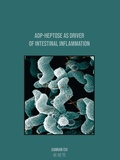ADP-heptose as driver of intestinal inflammation
Summary
A vast number of different of bacteria are always present in the human body. To control these bacteria, our immune system has put in place several elaborate defense systems that can sense their presence and start appropriate immune responses to prevent or stop bacterial infections. This first line of defense is in large part provided by the innate immune system and depends on one main principle: bacteria possess highly conserved structures that are only present in bacteria and not in the host. Such structures, which include specific proteins, lipids, specific types of DNA and small molecules, are known as pathogen-associated molecular patterns (PAMPs). However, this name is somewhat inaccurate: it is important to realize that PAMPs are not only present in bacterial pathogens but also in non-pathogenic bacteria. The innate immune system recognizes PAMPs using a set of distinct membrane and cytosolic receptors, including the Toll-like receptors, Nod-like receptors, and Lectin-like receptors. Through these so-called pattern recognition receptors (PRRs), the innate immune system effectively detects bacterial infections, often through by sensing them in places that should remain sterile, and initiates robust immune responses to fight infection and restore homeostasis, when necessary. The synthesis of the nucleotide sugar ADP-heptose is a critical step in the biogenesis of lipopolysaccharide (LPS) in Gram-negative bacterial species. However, it also has pro-inflammatory properties as it can activate the host cells’ ALPK1-TIFA-NF-B pathway. ADP-heptose is detected by the cytosolic PRR Alpha-kinase 1 (ALPK1). Only a few human bacterial pathogens, such as Neisseria meningitidis, Yersinia enterocolitica, Shigella flexneri, and Helicobacter pylori, have been shown to initiate inflammatory responses via ADP-heptose or related heptose phosphates. These bacteria, except for Neisseria species, directly inject or leak ADP-heptose into the cytoplasm of the host cell using a type 3 or 4 secretion system. However, given that purified ADP-heptose similarly activates the ALPK1-TIFA-NF-B axis when administered extracellularly to cultured human cells (including intestinal epithelial cells), it is likely that ADP-heptose that is released from bacteria near host cells can also induce proinflammatory responses. Human epithelial cells sense ADP-heptose and initiate a proinflammatory program that includes the release IL-8 and IL-6. The primary goal of the research presented in this thesis is to clarify the biological role of the PAMP ADP-heptose in intestinal inflammation, with a particular emphasis on C. jejuni infection, the normal microbiota, and the microbiota in inflammatory bowel disease (IBD). The research also aimed to discover possible novel bacterial anti-inflammatory mechanisms that may inhibit ADP-heptose signaling. In conclusion, the work described in this thesis shows that ADP-heptose is a fascinating molecule from a microbiota, inflammation, and health perspective. ADP-heptose has the potential to strongly influence the inflammatory state of the intestinal tract, as seen in IBD and C. jejuni infection.
